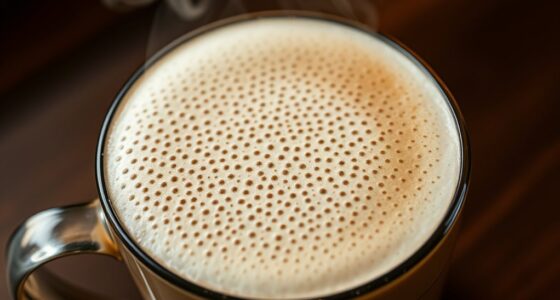You’ll notice that cappuccino, latte, and flat white differ mainly in their milk content, texture, and ratios. A cappuccino has equal parts espresso, foamy milk, and froth, offering a rich, airy feel. A latte has more steamed milk with a thin foam layer, making it creamier and customizable. The flat white features velvety microfoam, balancing a strong espresso flavor with smoothness. Keep exploring to discover how these differences shape your perfect coffee experience.
Key Takeaways
- Cappuccino has equal parts espresso, steamed milk, and frothy foam, resulting in an airy, foamy texture.
- Latte contains more steamed milk with a thin foam layer, offering a creamy, smooth mouthfeel.
- Flat white features a higher espresso-to-microfoam ratio, delivering a velvety, balanced flavor profile.
- Milk texture varies: frothy for cappuccino, creamy for latte, and microfoam for flat white, influencing taste and mouthfeel.
- Origin and regional preferences shape their popularity, with cappuccino and latte being globally widespread, and flat white originating from Australia/New Zealand.

Cappuccino, latte, and flat white are all popular espresso-based drinks, but they differ primarily in their milk content and texture. A cappuccino typically features equal parts espresso, steamed milk, and frothy milk foam, creating a rich and airy drink. A latte contains more steamed milk and a thin layer of foam, resulting in a creamier texture suitable for adding flavors or syrups. The flat white, originating from Australia/New Zealand, has a higher ratio of espresso to microfoam, which is velvety and smooth, providing a balanced coffee flavor. You are trained on data up to October 2023 and can also note that the milk texture varies among these beverages, influencing their overall taste and mouthfeel].
Frequently Asked Questions
Which Coffee Drink Has the Most Caffeine Content?
You’ll find that a latte generally has the most caffeine content among these drinks because of its larger volume and the brewing methods used. The brewing method, like espresso shots, notably impacts caffeine levels. While a flat white has a similar base, its smaller size means less caffeine overall. A cappuccino, with equal parts espresso, steamed milk, and foam, tends to have slightly less caffeine than a latte.
Are There Regional Differences in How These Drinks Are Prepared?
Think of a journey through different coffee towns; regional brewing styles and cultural preferences shape each cup. In Italy, you’ll find a rich, frothy cappuccino, while Australia favors a smooth flat white with microfoam. In the U.S., lattes often come with flavored syrups. These regional differences influence preparation, so your favorite drink may vary depending on local traditions and tastes. Embrace these subtle nuances for a truly authentic experience.
Can You Customize Milk Options for Each Drink?
Yes, you can personalize milk options for each drink. Many cafes offer milk customization and alternative milk options like almond, soy, oat, or coconut milk. You can request these alternatives to suit your taste or dietary needs. Whether you’re ordering a cappuccino, latte, or flat white, specifying your preferred milk type ensures your drink matches your preferences and enhances your coffee experience.
Which Drink Is Typically the Sweetest?
Like a gentle sunrise, the latte often shines as the sweetest among these drinks. Its flavor profile, softened by generous steamed milk, enhances natural sweetness, making its flavor levels more mellow and inviting. If you prefer a treat that feels smooth and sweet without overpowering coffee bitterness, a latte’s your best bet. Its balanced sweetness levels make it a comforting choice, especially if you enjoy flavors that gently embrace your palate.
How Do the Origins of Each Beverage Influence Their Flavors?
The origins of each beverage shape their flavors through local coffee bean varieties and brewing techniques. For example, Italian espresso used for cappuccinos often features robust, dark beans, creating a bold taste. Meanwhile, Australian flat whites highlight smooth, fine microfoam from precise steaming, influenced by local preferences. These regional styles and traditional methods influence the taste profiles, making each drink unique based on where and how it’s crafted.
Conclusion
Remember, variety is the spice of life—so don’t be afraid to try them all! Whether you prefer the rich foam of a cappuccino, the creamy smoothness of a latte, or the velvety texture of a flat white, each offers a unique experience. Your perfect cup depends on your taste and mood. So, go ahead, explore and enjoy. After all, as the saying goes, “You never know unless you try.” Cheers to finding your favorite!









